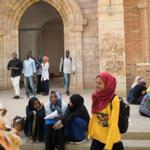The war for recruits, part II: The battle of charters
After Sudan’s transitional government was formed, the unity behind “Freedom, Peace, and Justice” fractured. Some kept protesting, others turned to deals, as opportunism—disguised as pragmatism—began to surface.
Scorching the surfaces to claim a future
At the center of this shift was a familiar logic: Stability first. Pushed by international donors, development agencies, and multilateral institutions, the idea was seductive—end the unrest, secure investments, and build institutions. But beneath it lay an implicit trade-off: Sacrifice justice for order, transformation for reform, and people’s demands for donor priorities.
During this Sudan’s resistance committees faced fragmentation, torn between calls for a “soft landing” and demands for “radical change.” Disillusionment and disappointment silenced the streets — but only briefly. The October 25 coup in 2022 reunified the resistance committees. Bound by trust, they asked: Who are we now? And how do we protect what we've built from the fractures of the past?
The answer came not in debate, but in resolve: No Negotiation. No Legitimacy. No Compromise. A vow. A shield. A line in the sand.
The effort led to drafting charters that solidified the Resistance Committees' vision, serving as a guide to unify and protect their movement from division and infiltration. This wasn't just a protest but a revolution with a plan and promise.
Instead of uniting under a revolutionary front, some parties pursued direct settlements with the military to secure political positions post-coup, exemplified by the Framework Agreement backed by the UN—highlighting the divide between politicians and revolutionaries and deepening resistance committees' suspicions of traditional forces and the international community.
NGO-ization, liberal peace, and the co-optation
The liberal peace model—emphasizing market liberalization, elite pacts, and technocratic governance—quickly became the dominant framework. This was not unique to Sudan. It was part of a global template, repurposed for “transitional” states: a path paved with workshops, grants, and civic trainings. But in Sudan, where the revolution had demanded deep redistribution and systemic accountability, this model rang hollow with clashing narratives.
The NGO-industrial complex, long embedded in Sudan since the 1980s, now returned with renewed purpose. It presented itself as a neutral bridge—but in practice, it served as a gatekeeper. Local actors learned that access to power—and funding—was increasingly determined not by their revolutionary credibility, but by their fluency in donor language.
A striking example is the local NGO “Sudan Civic Lab”, founded in 2021 by film maker Hajooj Kuka to rebuild civil society beyond traditional parties. It initially resonated with youth through nonpartisan participation, institutional reform, and civic education, tapping into widespread youth disillusionment with traditional parties—drawing in unaffiliated activists and channeling their energy from the streets into donor-funded programs that ultimately softened revolutionary demands.
Resistance Committees recently voiced concern[i]. They accused Civic Lab’s leadership of acting as intermediaries for foreign interests, not in overt espionage, but in practice—by offering alternatives to radical change in exchange for international legitimacy and security-sector buy-in. Civic workshops became substitutes for political vision. “Neutrality” became a mask for co-optation.
Pragmatism in chaos
Grief has dimmed the fire of Sudan’s youth. Their courage met tanks, bullets, and betrayal. After months of sacrifice, they were told to negotiate with their killers— “for peace”. But the result was more blood, more silence, and a generation left suspended between loss and rage.
This so-called peace was not born of justice or accountability. It was born of disguised pragmatism—a doctrine that treats compromise as wisdom, even when it comes at the cost of truth. Backed by international actors and regional brokers, this approach demanded that revolutionary movements trade moral clarity for political inclusion.
What this analysis misses, however, is that Sudan’s political trajectory is nonlinear—subject to sudden ruptures, feedback loops, and tipping points that cannot be managed through linear, technocratic fixes. The forces unleashed in 2019 were not just protest movements—they were complex systems responding to decades of repression, inequality, and institutional decay. Attempting to contain them within donor frameworks or elite settlements ignores this complexity and breeds further instability.
Beneath this logic lies a deeper betrayal. The revolution was not fought for procedural reforms or grant-funded roundtables. It was a call for citizenship, dignity, and redistribution—for breaking Sudan’s long history of military dominance and elite control. Yet, the post-revolution political architecture, shaped largely by international donors and NGOs, became a playground of programmatic polarization: Funding streams dictated agendas, and grassroots movements were fragmented into professionalized silos competing for legitimacy through donor frameworks rather than through the street.
NGOs, once seen as allies of transformation, became intermediaries in a depoliticized game. With international funding came conditionality—not overt, but structural. Local civil society organizations adapted, not by deepening their political roots, but by aligning with donor checklists. As a result, the revolutionary space became diluted—its unity fractured by the scramble for visibility, access, and survival.
In this ecosystem, the line between support and subversion blurred. Aid became a vector of influence. Activists were trained to “advocate” rather than mobilize, to “dialogue” instead of demand. The street became background noise to a new class of professionals fluent in project proposals but disconnected from the very communities they claimed to represent.
Sudan's rentier structures and corruption: Engines of failure
Beneath the political crisis lies a deeper wound: An economic model designed to serve the few at the expense of the majority. Successive Sudanese regimes—from military juntas to transitional cabinets—have embraced a distorted, rentier form of extractive capitalism rooted in privatization, corruption, and foreign dependence.
Corruption has been central to the collapse of Sudan’s pragmatic capitalist experiment. Rather than being driven by innovation or productivity, the economy was built on extractivism, cronyism and political loyalty. A parasitic capitalism emerged, where a narrow elite profited from state contracts, customs exemptions, and public resources without contributing real economic value.
This wasn’t capitalism as productivity, but capitalism as extraction. State assets were sold off without transparency. Land and industry were handed to cronies, militias, and foreign investors. What remained of the public sector was hollowed out—leaving millions jobless and entire regions excluded from basic services.
The revolution was, at its core, a revolt against this system. Protesters didn’t just call for the fall of a dictator—they demanded an end to an economic order that concentrated wealth in Khartoum and consigned the rest of the country to precarity. The People’s Authority Charters and similar grassroots documents explicitly called for economic justice, wealth redistribution, and local control of resources.
But the international response, shaped by institutions like the IMF and World Bank, offered only a familiar prescription: Stability through liberalization[ii]. That meant slashing subsidies, opening markets, and “reforming” the economy in line with investor confidence—despite its social consequences.
What these actors fail to recognize is that Sudan’s economic collapse is part of a nonlinear system, where political legitimacy, resource distribution, and institutional trust are deeply interdependent. Attempts to fix one sector in isolation—especially through imported, neoliberal frameworks—only generate ripple effects that destabilize the whole. Economic sovereignty in Sudan cannot be restored through piecemeal technocratic interventions; it demands structural transformation grounded in local realities.
In practice, the international approach sidelined revolutionary demands. Instead of structural change, Sudan was offered financial aid tied to compliance, capacity-building programs that didn’t reach the informal sector, and reform blueprints that favoured elite actors. Once again, foreign interests claimed to support the revolution while helping depoliticize it—reducing it to a technocratic project aimed at macroeconomic indicators, not material justice.
Now, after the war that erupted on April 15, this economic fragmentation has only deepened. Youth—once the vanguard of the revolution—find themselves pulled into competing narratives: The military, the RSF, and even NGOs now vie for their allegiance. Each offers resources, identity, or a vision of order. But none offer the justice that once lit the fires of 2019.
Conclusion
The battle for Sudan’s future is no longer fought only in the streets—it is now contested in language, funding frameworks, and competing charters. At its heart is a struggle over meaning: Whether the revolution will be remembered as a cry for bread, justice, and popular sovereignty—or reduced to a series of donor-led “transitions” managed by the very forces it rose against.
The Resistance Committees understood this early. Their charters were not idealistic wish lists; they were strategic interventions—an effort to reclaim the narrative and lay the foundation for a decentralized, just, and people-cantered democracy. These documents rejected elite pacts and foreign templates. They imagined a future built from below, one that cantered the street, not the state.
Today, that vision is under siege—from bombs and bullets, but also from boardrooms and bargaining tables and regional and international “peace initiatives”. Yet the revolution endures—not only in memory, but in the quiet infrastructures of mutual aid, the networks of trust, the enduring clarity of those early vows:
No Negotiation. No Legitimacy. No Compromise.
They had the seeds for a full garden. The question now is whether Sudan will be allowed to grow it—or whether it will be uprooted again before it blooms.
This Sudanese Perspectives blog post is written by Taharqa Elnour. Elnour is a Sudanese professional with a strong focus on health economics, community engagement, and visual storytelling. He has contributed to TB clinical trials in South Africa, playing a key role in establishing a Community Advisory Board and advocacy network to improve communication between researchers and the community, enhancing awareness of critical health issues.
Elnour is passionate about health economics, specifically how economic strategies can improve healthcare access and delivery, particularly in resource-limited settings. He is also known for his photography, notably documenting the 2019 Sudanese revolution, capturing themes of justice, freedom, and the power of art in social movements.
His work reflects a deep commitment to public health, social justice, and using creative expression to tell stories of resilience and hope.
This blog post is the second of two from Elnour, and is part of a series focusing on different aspects of youth’s responses to the war, and on the crucial role they can play in pushing for and building sustainable peace in Sudan. The series is the outcome of a SNAC workshop that brought together a large group of SNAC fellows and young Sudanese researchers and activists. The views expressed in this post are those of the author, and do not necessarily reflect the opinions of the SNAC project or CMI.
[i] Statement | Regarding the alleged Resistance Committees Conference - Khartoum State Resistance Committees Coordination
[ii] Creatures of the Deposed: Connecting Sudan’s Rural and Urban Struggles




